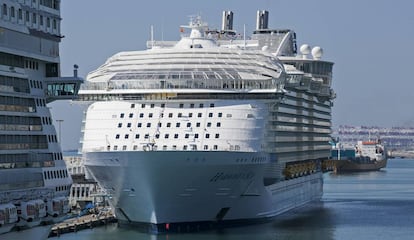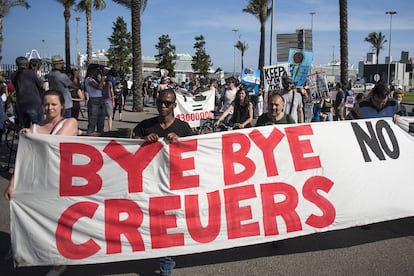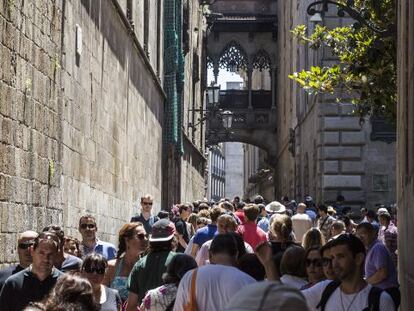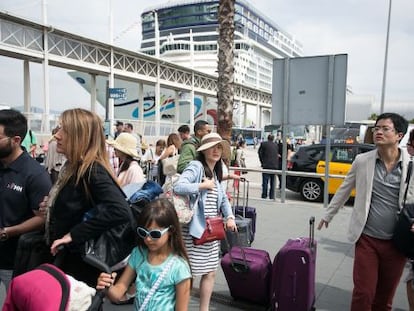Barcelona wrestles with the dilemma of the floating city
The city is to harbor the world’s biggest cruise liner, the ‘Harmony of the Seas,’ but the size of the vessel is dividing opinion among locals

The vessel that arrived recently in Barcelona isn’t a ship in the normal sense of the word. It is a high-rise maritime city of more than 9,000 inhabitants – 7,000 passengers and 2,000 staff – that will sail around the Mediterranean until October.
Gone are the days of the sleek and elegant liner. This beast is 72 meters high, 366 meters long and 66 meters wide, and boasts 23 swimming pools, 20 restaurants, a variety of giant water slides, a casino and a 1,400-capacity theater for Broadway shows. To shift this 227,000-ton brute, its engines consume a daily average of 110,000 liters of the most contaminating diesel in the world.
To shift this 227,000-ton brute, its engines consume a daily average of 110,000 liters of the most contaminating diesel in the world
Christened Harmony of the Seas, this is the jewel in the crown of the Royal Caribbean Cruises Ltd, a cruise line founded in Norway and based in Miami, Florida. This summer, it will make weekly forays into the Med from its base port of Barcelona. Sounds glamorous, but for Barcelona residents, the ship has come to symbolize all that is wrong with outsize cruises, triggering a debate already raging in other European ports such as Venice.
One of the major environmental problems is that ships of this size still run on fuel oil, an extremely polluting hydrocarbon that has the potential to contaminate 3,500 times more than diesel, while being infinitely cheaper. When anchored, the ship usually switches to a more refined fuel, but it is one that still pollutes 100 times more than normal diesel.
“This kind of heavy oil is now illegal on land because of its high sulfur content,” says María García, spokesperson for Ecologists in Action and the Platform for Quality Atmosphere. “At sea, the rules are more relaxed because it doesn’t come under the jurisdiction of any one country. The pollution produced by this ship is on a par with 73,000 high-maintenance homes.”
Aware of the complaints from Barcelona’s local population, City Hall will be carrying out emissions tests.

The city’s main concern is the ship’s engines running when it is anchored – there are almost no ships with the capacity to connect to the grid. According to City Hall, 7.6% of the city’s prominent air pollutant, nitrogen dioxide, comes from the port.
But with the data’s accuracy in dispute, Barcelona Mayor Ada Colau will measure the emissions again when the Harmony of the Seas is docked. A staunch critic of mass tourism for Barcelona, Colau has taken the complaints of the local populous on board and now says she will try to engineer a tax hike for cruise liners by improving the city’s fiscal system.
A key study of these floating cities was carried out in 2012 by German ecologists Nabu, with Axel Friedrich – whose research helped to expose the Volkswagen scandal – at the helm. According to Friedrich, a ship of this size can pump as much carbon dioxide into the atmosphere as 8,638 cars, with the same levels of NOx (the generic term for the mono nitrogen oxides NO and NO2) as 421,000 vehicles, and as much sulfur as 376 million cars. Daniel Rieger, Nabu’s transport specialist, emphasizes that the data is official and is based on average consumption.
Sulfur filters
The Vice President of the Royal Caribbean Corporation, Richard Pruitt, begs to differ, however. He suggests it is based on the worst case scenario possible. “All the figures included in this study assume that the ship is always running at full capacity,” he says. “They also suppose a sulfur content that is almost impossible nowadays. The calculations are based on a 3.5% sulfur content whereas it is actually 2%.”
Royal Caribbean points out that it complies with all current regulations and that its new sulfur filters, which allow it to continue using fuel oil in the port, have been certified by the Bahamas – its country of origin. “We are abiding by international law,” he concludes.
The environmental impact isn’t the only sticky issue for Barcelona. For some time, the Association of Neighbors for Sustainable Tourism (ABTS) have been pointing out the downside of spewing 2.6 million tourists into the city during the summer season. “You don’t get a more concentrated form of tourism than a cruise and the impact is intense,” says their spokesperson, Daniel Pardo. “We are talking about the invasion of public spaces at particular times of day in areas such as La Sagrada Familia, Boqueria and Park Güell. Commerce in these parts of the city increasingly caters for tourists, leaving little room for normal shops serving local needs.”
Neighborhoods such as the Gothic quarter are being turned into theme parks, say locals
Meanwhile, Reme Gomez, President of the Gothic Association, points to the destructive effect of 6,000 people coming ashore at one go in the Gothic Quarter, which has lost more local residents than any other neighborhood and is gradually being turned into a theme park.
The million-dollar question is, of course, what does the city gain? Royal Caribbean claims that the Harmony of the Seas brings €30 million to the local economy. Keen that Barcelona should remain a key industrial city, the port authorities have produced a study indicating that cruise liners generate a turnover of €796 million and contribute some €413.2 million to Catalonia’s gross national product as well as keeping 7,000 people in work.
The report also reveals that direct expenditure in the city from cruises amounts to €442.5 million annually – €121.2 million spent by the company itself, €315.8 million by passengers and €5.5 million by crew. Curiously, however, the study also reveals almost 60% of these people spend as little as 4.3 hours in the city – not much time to spend what works out as €53 each on Sundays, when the city’s stores are shut.
English version by Heather Galloway.
Tu suscripción se está usando en otro dispositivo
¿Quieres añadir otro usuario a tu suscripción?
Si continúas leyendo en este dispositivo, no se podrá leer en el otro.
FlechaTu suscripción se está usando en otro dispositivo y solo puedes acceder a EL PAÍS desde un dispositivo a la vez.
Si quieres compartir tu cuenta, cambia tu suscripción a la modalidad Premium, así podrás añadir otro usuario. Cada uno accederá con su propia cuenta de email, lo que os permitirá personalizar vuestra experiencia en EL PAÍS.
¿Tienes una suscripción de empresa? Accede aquí para contratar más cuentas.
En el caso de no saber quién está usando tu cuenta, te recomendamos cambiar tu contraseña aquí.
Si decides continuar compartiendo tu cuenta, este mensaje se mostrará en tu dispositivo y en el de la otra persona que está usando tu cuenta de forma indefinida, afectando a tu experiencia de lectura. Puedes consultar aquí los términos y condiciones de la suscripción digital.
More information
Últimas noticias
The complicated life of Francesca Albanese: A rising figure in Italy but barred from every bank by Trump’s sanctions
How Japan is trying to avert ‘digital defeat’
Half of Scotland is in the hands of 420 property owners
From digital curfews to blocking apps: How technology experts protect their children online
Most viewed
- Why we lost the habit of sleeping in two segments and how that changed our sense of time
- Trump’s obsession with putting his name on everything is unprecedented in the United States
- Charles Dubouloz, mountaineering star, retires at 36 with a farewell tour inspired by Walter Bonatti
- The Florida Keys tourist paradise is besieged by immigration agents: ‘We’ve never seen anything like this’
- Living in a motorhome due to soaring housing prices in Madrid: ‘I got used to it quickly, but I don’t idealize it’











































